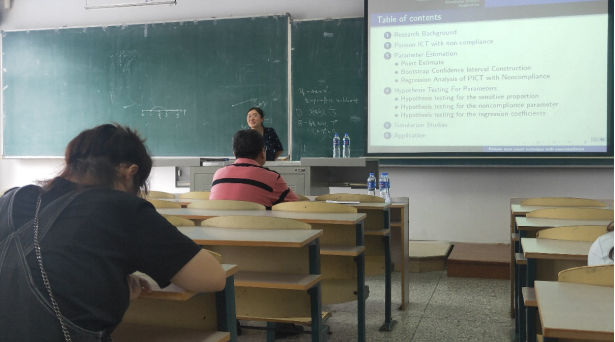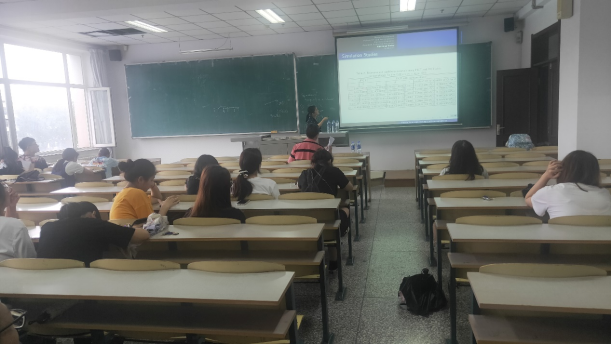2021年7月30日下午1点30分在南湖校区教学科研楼409室,华南师范大学吴琴博士莅临我院做学术报告,会议由数学与统计学院徐平峰教授主持,学院老师、研究生参加了本次学术报告会。

报告题目: Poisson item count technique with noncompliance
报告摘要: The Poisson Item Count Technique (PICT) is a survey method that was recently developed to elicit respondents' truthful answers to sensitive questions. It simplifies the well-known item count technique (ICT) by replacing a list of independent innocuous questions in known proportions with a single innocuous counting question. However, ICT and PICT both rely on the strong “no design effect assumption” (i.e., respondents give the same answers to the innocuous items regardless of the absence or presence of the sensitive item in the list) and “no liar” (i.e., all respondents give truthful answers) assumptions. To address the problem of self-protective behavior and provide more reliable analyses, we introduced a noncompliance parameter into the existing PICT. Based on the survey design of PICT, we considered more practical model assumptions and developed the corresponding statistical inferences. Simulation studies were conducted to evaluate the performance of our method. Finally, a real example of automobile insurance fraud was used to demonstrate our method.

吴琴简介:博士,现于华南师范大学统计系工作。曾主持国家自然科学基金项目1项,发表SCI论文7篇,相关研究成果被统计杂志Statistical Methods in Medical Research, Statistic in Medicine,Statistical Papers等杂志收录。

报告会中,吴琴博士首先讲解了众所周知的项目计数技术(ICT)及其应用背景,进一步表明该技术将已知比例的独立无害问题列表替换为单个无害计数问题,同时引出项目计数技术(ICT)的天花板和地板效应的缺点。但是,仍存在无论是否存在“不真实”的假设,受访者都会给出“不真实”答案的情况。随后,吴琴博士又向大家教授了解决回答者自我保护行为的问题并提供更可靠的分析模型的定义即泊松项目计数技术。进一步向大家展示了模型的矩估计,极大似然估计以及模型参数问题的解决。最后,吴琴博士向大家了介绍了其仿真研究的结果,可以看出当数据量足够大时该方法的性能很好。并通过一个汽车保险欺诈的实例形象地向大家展示PICT方法。实证使大家对于PICT方法有了更加深入的了解和兴趣。

会后,老师和同学们就感兴趣的内容与吴琴进行了广泛的讨论和交流,吴琴博士对学生们提出的问题进行了详细的解答,同时分享了自己的心得。本次学术交流会不仅拓展了同学们的学术视野,也激发了同学们的学习热情,聆听此次报告的师生均表示受益匪浅。
数学与统计学院
2021年7月30日